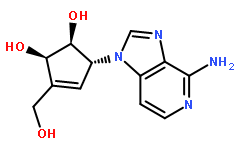| 中文名称: | 3-去氮腺嘌呤A | ||||
|---|---|---|---|---|---|
| 英文名称: | 3-Deazaneplanocin A | ||||
| 别名: | DZNep; 3-Deazaneplanocin | ||||
| CAS No: | 102052-95-9 | 分子式: | C12H14N4O3 | 分子量: | 262.26 |
| CAS No: | 102052-95-9 | ||||
| 分子式: | C12H14N4O3 | ||||
| 分子量: | 262.26 | ||||
包装规格:
1mg 5mg in glass bottle
产品简介:
一种有效的组蛋白甲基转移酶 (histone methyltransferase,EZH2) 抑制剂。3-Deazaneplanocin A 是一种有效的 S-腺苷同型半胱氨酸水解酶 (AHCY) 抑制剂。
溶解性:
Water:125 mg/mL (476.63 mM; 超声助溶)
储备液保存:
-80°C, 2 years
-20°C, 1 year
-20°C, 1 year
体内实验:
1、3-Deazaneplanocin A (DZNep) is prepared in PBS.
<1mg/ml表示微溶或不溶。
普西唐提供的所有化合物浓度为内部测试所得,实际溶液度可能与公布值有所偏差,属于正常的批间细微差异现象。
请根据产品在不同溶剂中的溶解度选择合适的溶剂配制储备液;一旦配成溶液,请分装保存,避免反复冻融造成的产品失效。
<1mg/ml表示微溶或不溶。
普西唐提供的所有化合物浓度为内部测试所得,实际溶液度可能与公布值有所偏差,属于正常的批间细微差异现象。
请根据产品在不同溶剂中的溶解度选择合适的溶剂配制储备液;一旦配成溶液,请分装保存,避免反复冻融造成的产品失效。
靶点:
EZH2
体外研究:
3-Deazaneplanocin A is a potent histone methyltransferase EZH2 inhibitor. Treatment of OCI-AML3 cells with 3-Deazaneplanocin A (1.0 μM) results in a significant increase in accumulation of cells in the G0/G1 phase (58.5%) with a concomitant decrease in the number of cells in S phase (35.2%) and G2/M phases (6.3%) of the cell cycle (P<0.05). Treatment with 3-Deazaneplanocin A (200 nM to 2.0 μM) for 48 hours, dose dependently, inhibits colony growth of OCI-AML3 and HL-60 cells. 3-Deazaneplanocin A reduces the expression of EZH2, especially after 72 hours (e.g. 48%, 32% and 36% reduction of EZH2 in PANC-1, MIA-PaCa-2 and LPc006 cells, respectively). 3-Deazaneplanocin A shows minimal growth inhibition in PANC-1 cells. More than 50% of these cells are still growing after exposure at the highest concentration (20 μM). MIA-PaCa-2 and LPc006 cells are much more sensitive, with IC0 values of 1±0.3 and 0.1±0.03 μM, respectively. 3-Deazaneplanocin A causes dose-dependent inhibition of cell proliferation of NSCLC cell lines, and the IC0 values range from 0.08 to 0.24 μM.
体内研究:
The survival of NOD/SCID mice with acute myeloid leukemia (AML) due to HL-60 cells is significantly higher, if treated with 3-Deazaneplanocin A and Panobinostat (PS) compare to treatment with PS, 3-Deazaneplanocin A, or vehicle alone (P<0.05). Median survival is as follows: control, 36 days; PS, 42 days; 3-Deazaneplanocin A, 43 days; and 3-Deazaneplanocin A plus PS, 52 days. There is a progressive increase in weight of rats treated with physiological saline in a time-dependent manner (the mean growth rate=3.19% per day). Administration of 20 mg/kg 3-Deazaneplanocin A not only markedly reduces the relative weight of the rats compare to the initial weight (−2.0%, −4.9% and −1.2%) in the first three days post-treatment, but also suppresses the weight growth rate to 2.6% per day from the fourth day onwards post-dose.
保存条件:
-20℃
注意事项:
1、为了您的安全和健康,请穿实验服并戴一次性手套操作。
2、以上信息仅做参考交流之用。
2、以上信息仅做参考交流之用。
UN码:
HazardClass:
危害声明:
安全说明:
搜索质检报告(COA)
参考文献 & 客户发表文献
本计算器可帮助您计算出特定溶液中溶质的质量、溶液浓度和体积之间的关系,公式为:
质量 (g) = 浓度 (mol/L) x 体积 (L) x 分子量 (g/mol)
摩尔浓度计算公式
用本工具协助配置特定浓度的溶液,使用的计算公式为:
开始浓度 x 开始体积 = 最终浓度 x 最终体积
稀释公式
稀释公式一般简略地表示为:C1V1 = C2V2 ( 输入 输出 )








